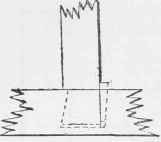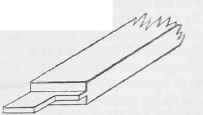Post And Beam Joints
Description
This section is from the book "Spons' Mechanics' Own Book: A Manual For Handicraftsmen And Amateurs", by Edward Spon. Also available from Amazon: Spons' Mechanics' Own Book.
Post And Beam Joints
The most common joint between posts and beams is the tenon and mortice joint, either wedged or fixed by a pin; the former arrangement is shown in Fig. 488, and the latter in Fig. 489. The friction of the wedges, when tightly driven, aided by the adhesion of the glue or white-lead with which they are coated, forms, in effect, a solid dovetail, and the fibres, being compressed, do not yield further by the shrinking of the wood. A framed door is an example of the application of this joint. When it is desired to tenon a beam into a post, without allowing the tenon to show through, or where a mortice has to be made in an existing post fixed against a wall, the dovetail tenon, shown in Fig. 490, is sometimes adopted, a wedge being driven in on the straight side to draw the tenon home and keep it in place. In joining small pieces, the foxtail tenon, shown in Fig. 491, has the same advantage as the dovetail tenon of not showing through, but it is more difficult to fix. The outer wedges are made the longest, and in driving the tenon home, these come into action first, splitting away the sides, and filling up the dovetailed mortice, at the same time compressing the fibres of the tenon.
This joint requires no glue, as it cannot draw out; should it work loose at any time, the only way to tighten it up would be to insert a very thin wedge in one end of the mortice. Short tenons, assisted by strap bolts, as shown in Fig. 492, are commonly adopted in connecting large timbers. The post is cut to form a shoulder so that the beam takes a bearing for its full width, the tenon preventing any side movement. When a post rests on a beam or sill piece, its movement is prevented by a "joggle," or stub-tenon, as shown in Fig. 493; but too much reliance should not be placed on this tenon, owing to the impossibility of seeing, after the pieces are fixed, whether it has been properly fitted, and it is particularly liable to decay from moisture settling in the joint. For temporary purposes, posts are commonly secured to heads and sills by dog-irons or " dogs,' Fig. 494; the pieces in this case simply butt against each other, the object being to avoid cutting the timber, and so depreciating its value, and also for economy of labour








Other forms of tenons are shown in Figs. 495 and 496. The double tenon is used in framing wide pieces, and the haunched tenon when the edge of the piece on which the tenon is formed is required to be flush with the end of the piece containing the mortice. In Figs. 497 and 498 are shown 2 forms of bridle joint between a post and beats.


Tredgold recommended a bridle joint with a circular abutment, but this is not a correct form, as the post is then equivalent to a column with rounded ends, which it is well known is unable in that form to bear so great a load before it commences to yield.
Continue to:


